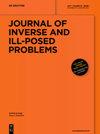Simultaneous determination of mass density and flexural rigidity of the damped Euler–Bernoulli beam from two boundary measured outputs
IF 1
4区 数学
Q2 MATHEMATICS
引用次数: 0
Abstract
Abstract In this paper, we study the inverse coefficient problem of identifying both the mass density ρ ( x ) > 0 \rho(x)>0 and flexural rigidity r ( x ) > 0 r(x)>0 of a damped Euler–Bernoulli (cantilever) beam governed by the equation ρ ( x ) u t t + μ ( x ) u t + ( r ( x ) u x x ) x x = 0 \rho(x)u_{tt}+\mu(x)u_{t}+(r(x)u_{xx})_{xx}=0 , ( x , t ) ∈ ( 0 , ℓ ) × ( 0 , T ) (x,t)\in(0,\ell)\times(0,T) , subject to boundary conditions u ( 0 , t ) = u x ( 0 , t ) = 0 u(0,t)=u_{x}(0,t)=0 , u x x ( ℓ , t ) = 0 u_{xx}(\ell,t)=0 , - ( r ( x ) u x x ( x , t ) ) x | x = ℓ = g ( t ) -(r(x)u_{xx}(x,t))_{x}|_{x=\ell}=g(t) , from the available measured boundary deflection ν ( t ) := u ( ℓ , t ) \nu(t):=u(\ell,t) and rotation θ ( t ) := u x ( ℓ , t ) \theta(t):=u_{x}(\ell,t) at the free end of the beam. The distinctive feature of the considered inverse coefficient problem is that not one, but two Neumann-to-Dirichlet operators have to be formally defined. The inverse problem is hence formulated as a system of nonlinear Neumann-to-Dirichlet operator equations with the right-hand sides consisting of the measured outputs. As a natural consequence of this approach, a vector-form Tikhonov functional is introduced whose components are squares of the L 2 L^{2} -norm differences between predicted and measured outputs. We then prove existence of a quasi-solution of the inverse problem and derive explicit gradient formulae for the Fréchet derivatives of both components of the Tikhonov functional. These results are instrumental to any gradient based algorithms for reconstructing the two unknown coefficients of the considered damped Euler–Bernoulli beam.从两个边界测量输出同时确定阻尼Euler–Bernoulli梁的质量密度和弯曲刚度
摘要本文研究了质量密度ρ∑(x) >的反系数问题 \rho一个阻尼欧拉-伯努利(悬臂)梁的弯曲刚度r(x)>0 r(x)>0 r(x)>0由方程ρ (x)减去u t减去t + μ (x)减去u t + (r(x)减去u x减去x) x减去x = 0 \rho(x)u{tt}+\mu(x)u{t}+(r(x)u{xx}){xx}=0, (x,t)∈(0,r) x (0,t) (x,t)\in(0;\ell)\times(0,T),满足边界条件u∑(0,T) =u x∑(0,T) = 0 u(0, T) =u_{x}(0,t)=0, u x乘以x乘以(r,t)等于0{xx}(\ell,t)=0, -(r减去(x)减去u x减去x减去x减去(x,t)) x | x = r = g减去(t{xx}(x,t))_{x}|_{x=\ell}=g(t),从可测边界位移ν∑(t):= u∑(r, t) \nu(t):=u(\ell,t)和旋转θ∑(t):= u x∑(r,t) \theta(t):=u_{x}(\ell,t)在梁的自由端。所考虑的逆系数问题的显著特征是,不是一个,而是两个诺伊曼-狄利克雷算子必须被正式定义。因此,反问题被表述为一个非线性诺伊曼-狄利克雷算子方程系统,其右侧由测量输出组成。作为这种方法的自然结果,引入了一个矢量形式的吉洪诺夫泛函,其分量是l2l ^的平方{2} -预测输出和测量输出之间的规范差异。然后证明了逆问题的拟解的存在性,并推导出Tikhonov泛函两个分量的fr导数的显式梯度公式。这些结果有助于任何基于梯度的算法重建考虑阻尼欧拉-伯努利梁的两个未知系数。
本文章由计算机程序翻译,如有差异,请以英文原文为准。
求助全文
约1分钟内获得全文
求助全文
来源期刊

Journal of Inverse and Ill-Posed Problems
MATHEMATICS, APPLIED-MATHEMATICS
CiteScore
2.60
自引率
9.10%
发文量
48
审稿时长
>12 weeks
期刊介绍:
This journal aims to present original articles on the theory, numerics and applications of inverse and ill-posed problems. These inverse and ill-posed problems arise in mathematical physics and mathematical analysis, geophysics, acoustics, electrodynamics, tomography, medicine, ecology, financial mathematics etc. Articles on the construction and justification of new numerical algorithms of inverse problem solutions are also published.
Issues of the Journal of Inverse and Ill-Posed Problems contain high quality papers which have an innovative approach and topical interest.
The following topics are covered:
Inverse problems
existence and uniqueness theorems
stability estimates
optimization and identification problems
numerical methods
Ill-posed problems
regularization theory
operator equations
integral geometry
Applications
inverse problems in geophysics, electrodynamics and acoustics
inverse problems in ecology
inverse and ill-posed problems in medicine
mathematical problems of tomography
 求助内容:
求助内容: 应助结果提醒方式:
应助结果提醒方式:


